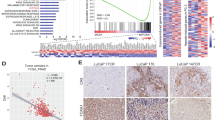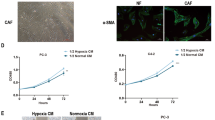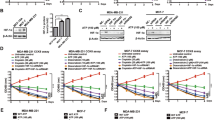Abstract
Hypoxia has been previously linked to the development of both benign prostatic hyperplasia and prostate cancer. This study investigated the effect of maspin, an extracellular matrix (ECM) tumor suppressor, on the apoptotic response of prostate cancer cells to hypoxia. Gene expression profiling of human benign and malignant prostate epithelial cells after exposure to hypoxia or normoxia revealed dramatic changes in ECM regulators. Maspin was found to be overexpressed in response to hypoxia in prostate cancer cells, but not in benign prostate cells. To dissect the contribution of maspin to tumor cell responses within a hypoxic microenvironment, we used maspin-overexpressing DU-145 human prostate cancer cells. Exposure to hypoxic conditions (1% O2) led to a significant increase in apoptosis in the DU-145 maspin cells, compared to DU-145 neo-transfectants without a significant effect on cell migration. This enhanced sensitivity to hypoxia-induced apoptosis leads to a significant suppression of tumor growth and tumor vascularity in vivo by targeting Akt and focal adhesion kinase activation. Our findings implicate maspin in prostate cancer cell response to hypoxia via recruitment of intracellular signaling partners. This study may have significance in the identification of maspin-driven therapeutic targeting in advanced metastatic prostate cancer.
This is a preview of subscription content, access via your institution
Access options
Subscribe to this journal
Receive 50 print issues and online access
$259.00 per year
only $5.18 per issue
Buy this article
- Purchase on Springer Link
- Instant access to full article PDF
Prices may be subject to local taxes which are calculated during checkout





Similar content being viewed by others
Abbreviations
- BPH-1:
-
benign prostatic hyperplasia cells
- ECM:
-
extracellular matrix
- FAK:
-
focal adhesion kinase
- HIF-1α:
-
hypoxia-inducible factor-1α
- SDS-PAGE:
-
SDS–polyacrylamide gel electrophoresis
- TGF-β:
-
transforming growth factor-β1
- TUNEL:
-
terminal deoxynucleotidyl transferase biotin-dUTP nick end labeling
- VEGF:
-
vascular endothelial growth factor
References
Abraham S, Zhang W, Greenberg N, Zhang M . (2003). Maspin functions as tumor suppressor by increasing cell adhesion to extracellular matrix in prostate tumor cells. J Urol 169: 1157–1161.
Amir S, Margaryan NV, Odero-Marah V, Khalkhali-Ellis Z, Hendrix MJ . (2005). Maspin regulates hypoxia-mediated stimulation of uPA/uPAR complex in invasive breast cancer cells. Cancer Biol Ther 4: 400–406.
Blacque O, Worrall D . (2002). Evidence for a direct interaction between the tumor suppressor serpin, maspin, and types I and III collagen. J Biol Chem 277: 10783–10788.
Cher M, Biliran Jr H, Bhagat S, Meng Y, Che M, Lockett J et al. (2003). Maspin expression inhibits osteolysis, tumor growth, and angiogenesis in a model of prostate cancer bone metastasis. Proc Natl Acad Sci USA 100: 7847–7852.
Corley KM, Taylor CJ, Lilly B . (2005). Hypoxia-inducible factor 1 alpha modulates adhesion, migration and FAK phosphorylation in vascular smooth cells. J Cell Biochem 96: 971–985.
Denk AE, Bettstetter M, Wild PJ, Hoek K, Bataille F, Dietmaier W et al. (2007). Loss of maspin expression contributes to a more invasive potential in malignant melanoma. Pigment Cell Res 20: 112–119.
Debes JD, Tindall DJ . (2004). Mechanisms of androgen-refractory prostate cancer. New Engl J Med 351: 1488–1490.
Domann F, Rice J, Hendrix M, Futscher B . (2000). Epigenetic silencing of maspin gene expression in human breast cancers. Int J Cancer 85: 805–810.
Ferrara N, Gerber H, LeCouter J . (2003). The biology of VEGF and its receptors. Nat Med 9: 669–676.
Fu X, Choi E, Bubley G, Balk S . (2005). Identification of hypoxia inducible factor-1α (HIF-1α) polymorphism as a mutation in prostate cancer that prevents normoxia-induced degradation. Prostate 63: 215–221.
Gao N, Shen L, Zhang Z, Leonard SS, He H, Zhang XG et al. (2004). Arsenite induces HIF-1alpha and VEGF through PI3 K, Akt and reactive oxygen species in DU145 human prostate carcinoma cells. Mol Cell Biochem 255: 33–45.
Garrison JB, Shaw Y-J, Chen C-S, Kyprianou N . (2007). Novel quinazoline-based compounds impair prostate tumorigenesis by targeting tumor vascularity. Cancer Res 67: 11344–11352.
Jemal A, Siegel R, Ward E, Murray T, Xu J, Smigal C et al. (2006). Cancer Statistics, 2006 CA. Cancer J Clin 56: 106–130.
Jiang N, Meng Y, Zhang S, Mensah-Osman E, Sheng S . (2002). Maspin sensitizes breast carcinoma cells to induced apoptosis. Oncogene 21: 4089–4098.
Kimbro KS, Simons JW . (2006). Hypoxia-inducible factor-1 in human breast and prostate cancer. Hypoxia-inducible factor-1 in human breast and prostate cancer. Endocr Relat Cancer 13: 739–749.
Kyprianou N, Bruckheimer EM, Guo Y . (2000). Cell proliferation and apoptosis in prostate cancer: significance in disease progression and therapy. Histol Histopathol 15: 1211–1223.
Lee BL, Kim WH, Jung J, Cho SJ, Park JW, Kim J et al. (2008). A hypoxia-independent up-regulation of hypoxia-inducible factor-1 by AKT contributes to angiogenesis in human gastric cancer. Carcinogenesis 29: 44–451.
Lee SM, Lee CT, Kim YW, Han SK, Shim YS, Yoo CG . (2006). Hypoxia confers protection against apoptosis via PI3K/Akt and ERK pathways in lung cancer cells. Cancer Lett 242: 231–238.
Liu J, Yin S, Reddy N, Spencer C, Sheng S . (2004). Bax mediates the apoptosis-sensitizing effect of maspin. Cancer Res 64: 1703–1711.
McKenzie S, Kyprianou N . (2006). Apoptosis evasion: the role of survival pathways in prostate cancer progression and therapeutic resistance. J Cell Biochem 97: 18–32.
Ngamkitidechakul C, Warejcka D, Burke J, O’Brien W, Twinning S . (2003). Sufficiency of the reactive site loop of maspin for induction of cell-matrix adhesion and inhibition of cell invasion. J Biol Chem 278: 31796–31806.
Rennebeck G, Martelli M, Kyprianou N . (2005). Anoikis and survival connections in the tumor microenvironment: is there a role in prostate cancer metastasis. Cancer Res 65: 11230–11235.
Rofstad EK, Mathiesen B, Henriksen K, Kindem K, Galappathi K . (2005). The tumor bed-effect: increased metastatic dissemination from hypoxia-induced up-regulation of metastasis-promoting gene products. Cancer Res 65: 2387–2396.
Schaefer J, Zhang M . (2003). Role of maspin in tumor metastasis and angiogenesis. Curr Mol Med 3: 653–658.
Semenza G . (2002). HIF-1α and tumor progression: pathophysiology and therapeutics. Trends Mol Med 8: 62–67.
Semenza G . (2003). Targeting HIF-1α for Cancer Therapy. Nat Rev Cancer 3: 721–732.
Sheng S, Carey J, Seftor EA, Dias L, Hendrix MJ, Sager R . (1996). Maspin acts at the cell membrane to inhibit invasion and motility of mammary and prostatic cancer cells. Proc Natl Acad Sci USA 93: 11669–11674.
Shi YH, Wang YX, Bingle L, Gong LH, Heng WJ, Li Y et al. (2005). In vitro study of HIF-1 activation and VEGF release by bFGF in the T47D breast cancer cell line under normoxic conditions: involvement of PI-3K/Akt and MEK1/ERK pathways. J Pathol 205: 530–536.
Tahmatzopoulos T, Sheng S, Kyprianou N . (2005). Maspin sensitizes prostate cancer cells to doxazosin-induced apoptosis. Oncogene 24: 5375–5383.
Welsh S, Powis G . (2003). Hypoxia inducible growth factors as a cancer drug target. Curr Cancer Drug Targets 3: 391–405.
Zhang M, Volpert O, Shi Y, Bouck N . (2000). Maspin is an angiogenesis inhibitor. Nat Med 6: 196–199.
Zou Z, Anisowicz A, Hendrix MJ, Thor A, Neveu M, Sheng S et al. (1994). Maspin, a serpin with tumor-suppressing activity in human mammary epithelial cells. Science 263: 526–529.
Acknowledgements
This work was supported by a grant from the National Institutes of Health, NIH CA107575-01 (NK). We thank Menglei Zhu for expert assistance with the preparation of the figures and Lorie Howard for help with the paper submission.
Author information
Authors and Affiliations
Corresponding author
Additional information
Supplementary Information accompanies the paper on the Oncogene website (http://www.nature.com/onc)
Supplementary information
Rights and permissions
About this article
Cite this article
McKenzie, S., Sakamoto, S. & Kyprianou, N. Maspin modulates prostate cancer cell apoptotic and angiogenic response to hypoxia via targeting AKT. Oncogene 27, 7171–7179 (2008). https://doi.org/10.1038/onc.2008.321
Received:
Revised:
Accepted:
Published:
Issue Date:
DOI: https://doi.org/10.1038/onc.2008.321
Keywords
This article is cited by
-
Maspin suppresses cell invasion and migration in gastric cancer through inhibiting EMT and angiogenesis via ITGB1/FAK pathway
Human Cell (2020)
-
Recombinant human maspin inhibits high glucose-induced oxidative stress and angiogenesis of human retinal microvascular endothelial cells via PI3K/AKT pathway
Molecular and Cellular Biochemistry (2018)
-
Role of maspin in cancer
Clinical and Translational Medicine (2013)
-
Effect of epigenetic modification of maspin on extravillous trophoblastic function
Journal of Huazhong University of Science and Technology [Medical Sciences] (2012)
-
Latexin expression is downregulated in human gastric carcinomas and exhibits tumor suppressor potential
BMC Cancer (2011)



